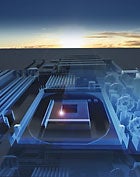Memristor circuits lead to ultra small PCs. Intel and AMD unleash massively multicore CPUs. Samsung TVs respond to your every gesture. These and other developing technologies will fundamentally change the way you think about--and use--technology.
Researchers at Hewlett-Packard developed a working unit of a memory circuit that has existed in theory for 37 years, which could ultimately replace RAM and make computers more intelligent by tracking data it has retained.
The technology, called memristor, allow computers to make decisions by understanding past patterns of data it has collected, similar to human brains collecting and understanding a series of events.
For example, a memristor circuit could be capable of telling a microwave the heating time for different food types based on the information it has collected over time, said Stanley Williams, senior fellow at HP.
A memristor circuit requires lower voltage and less time to turn on than competitive memory like DRAM and flash, Williams said. "Because it [uses] less voltage and less time, of course, it uses much less power," Williams said. Denser cells also allow memristor circuits to store more data than flash memory.
Through prototypes, HP is trying to show circuit designers what memristor is capable of doing. "What we have done is confirmed a concept for a new electronic device that was originally proposed nearly 40 years ago," Williams said.
Memristor is the fourth fundamental circuit
element, joining the other three -- resistor, capacitor and inductor -- that had been known for 150 years, Williams said. The element has properties that cannot be duplicated by any combination of the other three elements, Williams said.
"It is as fundamental to electronic engineering as a chemical element is to chemistry or an electron is to physics," Williams said.
In a 1971 academic paper, Leon Chua, a mathematician and professor at the University of California at Berkeley, wrote that memristor would have properties similar to a synapse in a brain. The synapse makes connections between two neurons, and the more often a signal is sent to a synapse, the stronger the synapse gets.
"That is a very different type of behavior than anything that had been observed before in circuit elements," Williams said.
HP is not going to reproduce all the functions of a brain in memristor, but the company is trying to build a relatively simple computing machine that operates on a different principle from today's computers, Williams said.
The scientists created the memory by applying a charge on a circuit with blocks of titanium dioxide. The actual resistance of the memristor changes depending on the amount of current flowing through the circuit, Williams said. When the current is turned off, the memory retains the information it has acquired.
Although the concept of memristor has existed for a while, the memory prototype is an academic device that will first work its way to academia.
 The memristor is expected to be far cheaper and faster than flash storage. A theoretical concept since 1971, it has now been built in labs and is already starting to revolutionize everything we know about computing, possibly making flash memory, RAM, and even hard drives obsolete within a decade.
The memristor is expected to be far cheaper and faster than flash storage. A theoretical concept since 1971, it has now been built in labs and is already starting to revolutionize everything we know about computing, possibly making flash memory, RAM, and even hard drives obsolete within a decade. The memristor is just one of the incredible technological advances sending shock waves through the world of computing. Other innovations in the works are more down-to-earth, but they also carry watershed significance. From the technologies that finally make paperless offices a reality to those that deliver wireless power, these advances should make your humble PC a far different beast come the turn of the decade.




No comments:
Post a Comment